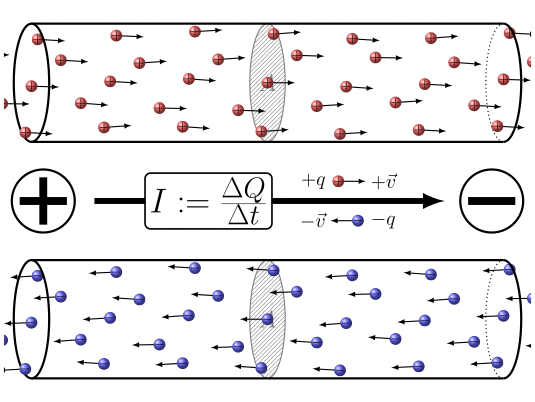Concept of Electric Current
In this article, we will study about the concept of current, how it gets produced, and its major types.
 Table of Contents
Table of Contents- What is Electric Current?
- Types of Electric Current
- What is an Electric Cell?
What is Electric Current?
Definition of Electric Current
Flow of electric charges is called electric current.
- If the current is produced by positive charges, then the direction of current is the same as the direction of the flow of positive charges. Such a current flows from a high potential to a low potential.
- If the current is produced by negative charges, then the direction of current is opposite to the direction of the flow of negative charges. Such a current flows from a low potential to a high potential.
Most of the conductors we use in our daily life are metallic, e.g. copper, silver, etc. In metallic substances, electrons work as charge carriers. So, conventional current flows opposite to the direction of flow of electrons.
Formula of Electric Current
Current = Charge/Time
Or I = Q/t
- The SI unit of current is Ampere.
- Current is measured by using an Ammeter.
- Though electric current has both magnitude and direction, it’s not considered a vector quantity. Rather its regarded as a scalar quantity. That’s because it doesn’t obey the triangle law of vector addition or parallelogram law of vectors.
Various types of Conductors
- Solid conductors: In solid conductors (e.g. metals), electric current is produced by the electrons (as atoms are strongly bound together). In solid conductors, such as metals, some electrons are free to move within the bulk material. So, when electric field is applied across them, electric current is produced in them. Though all solids do not have these free electrons, and so no electric current is produced in them even if an electric field is applied.
- Liquid conductors: In liquid conductors (e.g. electrolytic solutions), electric current is produced by ions and electrons, i.e. through both the charge carriers.
- Semiconductors: In semiconductors, electric current is produced by holes and electrons, i.e. through both the charge carriers.
Mechanism of Electric Current production in Solid Conductors
In solid conductors, the current is carried by the negatively charged electrons. While the positive ions remain fixed at their position.
Case 1: No electric field is applied
In a solid conductor, in its normal state, the free electrons move randomly due to thermal motion. They collide with each other and the positive ions and keep on changing their direction. As these electrons do not flow in a specific direction, no net electric current is produced in the conductor.
Case 2: Electric field is applied
Now, let’s apply an electric field across the two ends of a solid conductor. For example, let’s take a cylindrical solid conductor and attach two thin circular discs of the same radius on the two flat surfaces of the cylinder – one having a positive charge +Q distributed over it, and the other having a negative charge -Q distributed over it.

This will create an electric field directed from the positive towards the negative charge. Obviously, the electrons, being negatively charged, will move/drift towards the positive charge to neutralize it, i.e. opposite to the applied electric field. The moving electrons will constitute an electric current in the opposite direction, i.e. in the same direction as the electric field.
If the ends of the cylinder are neutralized, the electric current will stop. However, if we keep on providing fresh charges to these ends (to make up for any charges neutralised by electrons), the electric current will keep on flowing in a steady manner inside the conductor. For example, cells and batteries maintain a steady electric field and this mechanism ensures a continuous electric current (rather than an electric current for a short period of time).
Types of Electric Current
There are two types of electric currents.
Direct Current (DC)
An electric current whose magnitude and direction do not change with time is called direct current.
Alternating Current (AC)
An electric current whose magnitude changes continuously and direction changes periodically is called alternating current.
Alternating current is the current that is delivered to our houses and factories. The frequency of AC that we generally use is 50 Hz.
 Note
NoteUnlike DC, a big drawback of AC is that we cannot store it in an accumulator cell. So, often DC is stored in batteries and then a device called Inverter is used to convert DC to AC.
What is an Electric Cell?
An electric cell is a device which converts chemical energy into electrical energy.
Electric Cells are of two types:
Primary cell: Primary cell cannot be charged. Some examples of primary cells are Voltaic, Daniell and Leclanche cells.
Secondary cell: Secondary cell can be charged again and again. Some examples of secondary cells are acid and alkali accumulators.
Emf of an Electric Cell
Emf (i.e. electromotive force) of an electric cell is the work done by the cell to bring a positive charge from its one terminal to the other.
So, the word “force” in Emf is a misnomer – Emf is work and not a force.
